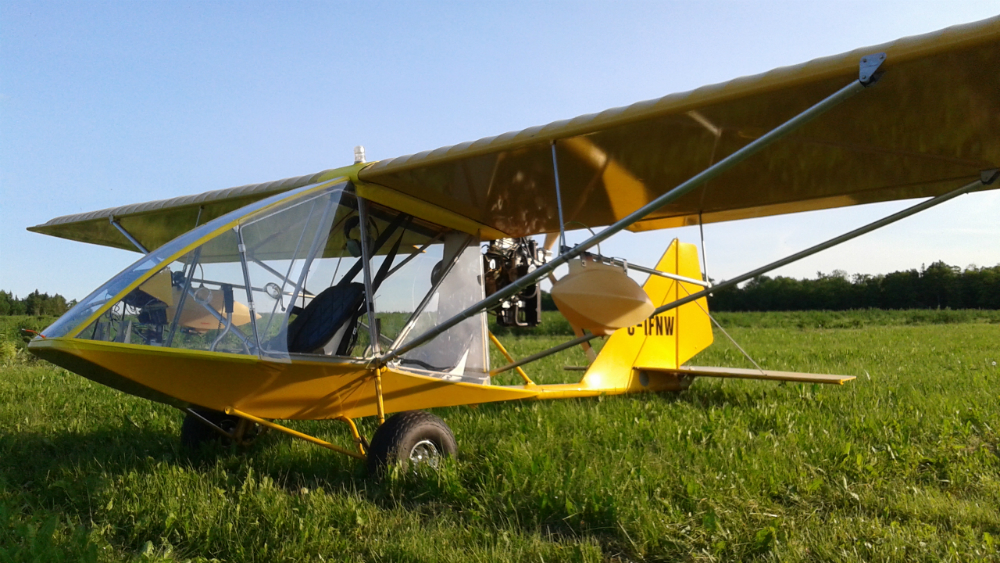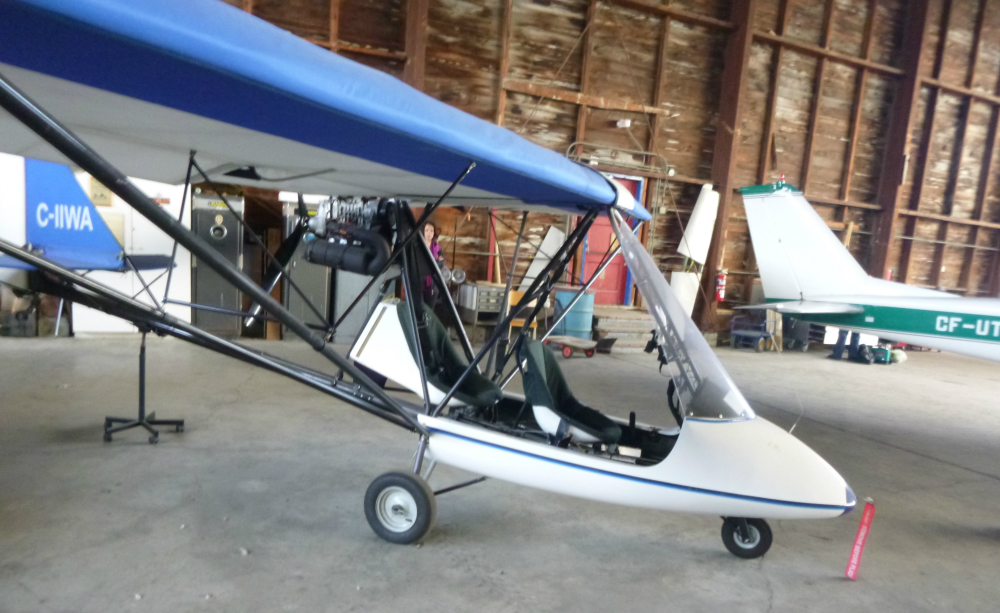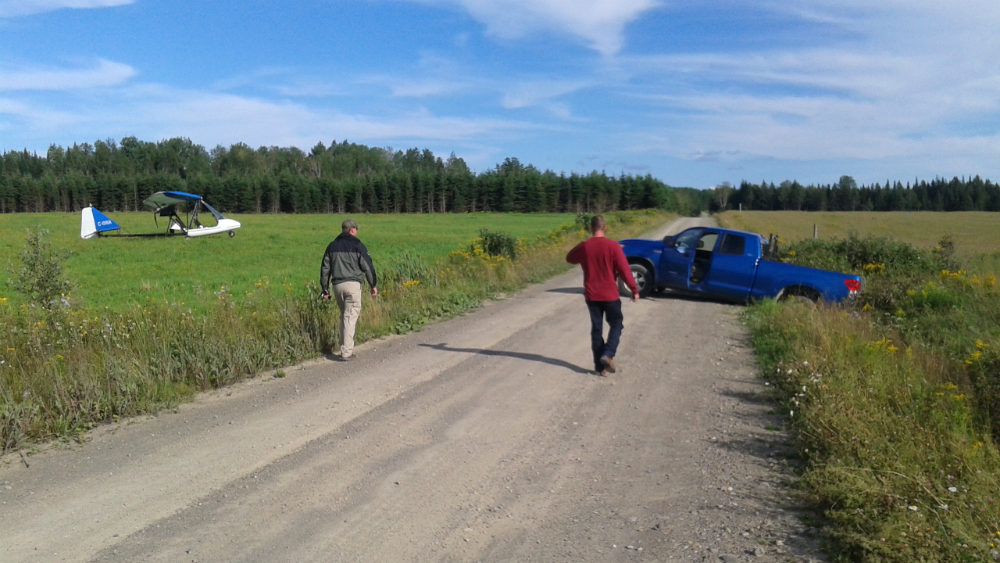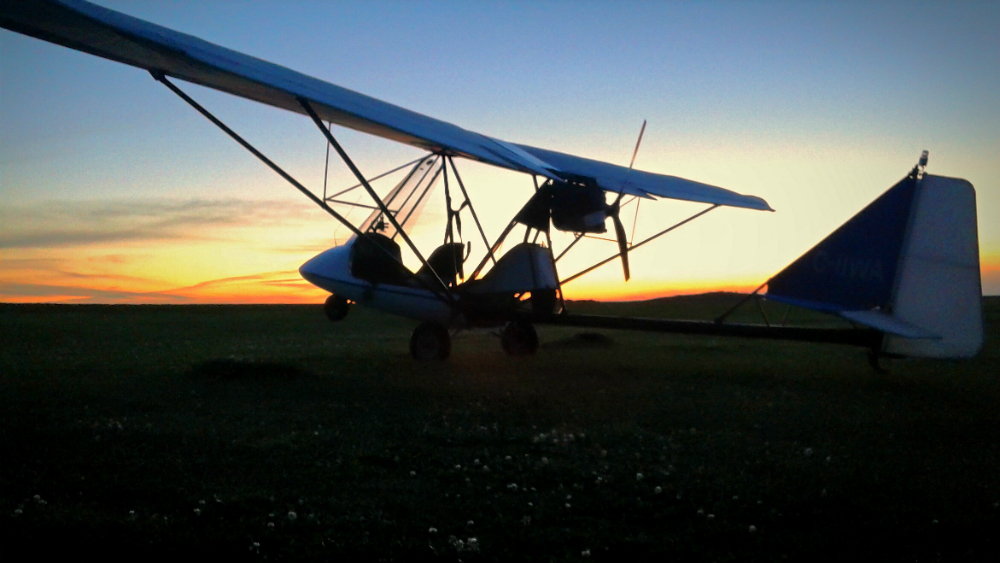So a buddy (Owen) and I (Matthew) have been working on starting an ultralight flight school. (just so there's no confusion since HBA members are mostly American, up here in Canada, ultralights can include aircraft up to a gross weight of 1232 lbs)
Back when I first started flying in 1996, I logged a few hours in a Chinook Plus 2. I fell in love with it at the time and so when we were finally in a position to purchase our first airplane, that's what we went with.

The Chinook is a great airplane, but it has one major drawback when it comes to teaching new pilots - it's a taildragger. Now that being said, it's not that hard to learn and I do recommend that all pilots that fly ultralights (or Light Sport Aircraft in the US) get at least some time in a taildragger. It's a great skill to have.
Since we want to make the initial training for new pilots as easy as possible, we decided we should pick up a tricycle gear airplane. We wanted something simple, easy to fly, and rugged. The Challenger is a very popular ultralight at the airport we operate out of but the landing gear seems to be the Achilles heel since we wanted something we could confidently land off airport.
After looking around and doing some research, we decided that the Spectrum Beaver might be our best option. It's currently made by the same company that makes the Chinook and we heard favourable reviews from current and previous owners as well as good reviews online.
We found one for a really good price about 130 miles away. Easily close enough to ferry it home. So yesterday, we grabbed another friend (Matt, not to be confused with me, Matthew) and hit the road. All went well during the inspection and all questions were answered to our satisfaction and the test flight went very well. Money changed hands and we were now the proud new owners of a 1987 Spectrum Beaver.

With our indicated cruise speed of 60 MPH, our destination being 130 miles away, and having only 7 gallons of fuel, we knew that we'd be stopping at least once to re-fuel since the plane burns about 3.5 gallons per hour. Our plan was to land at an airport pretty close to half way. So we brim the tank, climb in and take off. As we begin to climb, I notice that the tachometer (a Stratomaster E1) is fluctuating wildly between 9999 and 4000 rpm. In retrospect, that obviously can't be right, but for a few brief seconds I was extremely concerned. We double checked everything that we could which was really only the choke. It was in the correct position and as I realized that the plane was performing as it should be, I settled on the conclusion that there was obviously something wrong with the instrument, not the engine.
With that little hiccup behind us, we continued on toward our destination. The airspeed indicator was pegged at 60 mph and so far the math was looking good to get us there with the fuel we had on board. Being an open cockpit, I very carefully retrieved my phone from my pocket and conferred with its GPS. (I use an app called Canada Topo Maps which has all the tools and features I need for backup navigation on VFR flights) It told me that my ground speed was 50 mph which was concerning since there was very little wind forecast, and what wind there was, was supposed to be a tailwind. Perhaps the airspeed indicator was not right...?
I had consulted the maps earlier and knew that there were no other listed airports between us and our destination so we either had to make it or land off airport to re-fuel. As we watched the fuel disappear faster than the miles in front of us, we resigned ourselves to the fact that we needed to find a field. We contacted Matt via text message and told him that we were about to land and planned on texting him our exact location after we landed. We spotted a nice field close to the highway and near some houses. This was the Beaver's first chance to prove her ruggedness.
I throttled back, entered a modified downwind, turned base and final in one smooth turn, came in over the trees, slowed to 50 mph, and set it down fairly smoothly at about 45 mph. As the long grass grabbed at the wheels the plane decelerated very quickly. We went over one hump in the field at about 35 mph and became airborne again for about 20 feet but the plane re-settled nicely and soon we were at a stop.
It was when we went to text Matt of our exact location that we noticed that we had no cell signal on the ground. Fortunately we had made the decision to land near the road and near houses. Owen and I started to walk to the nearest house and were just about to knock on the door when Matt drives by. He had seen the plane in the field but didn't notice Owen and I as he drove by. He turned down a dirt road to get closer to the plane.
Now he claims that he checked the ditches before he started to turn around (and I'm sure he did, but what's the point of having friends if you can't make fun of them once in a while?) but apparently the ditch suddenly increased in depth shortly after he checked. As he backed up, the back end of the truck dropped into the almost 4 foot ditch and he was definitely stuck.

So there we were, the plane almost out of gas and the truck immovable. As we contemplated our options, a local came along on his four-wheeler and told us he had a tractor that could get the truck out. Phew! So off he went to get that and in short order, the truck was freed from the ditch with next to no damage. (a slightly dented muffler) With many thanks and a declined offer of $20 to the farmer, Matt and Owen went off to find a gas station.
A half hour or so later, the plane was full of gas again and we were ready to continue on. Owen and I climbed back into the Beaver and I taxied it across the field and up a slight hill. I turned into the the almost non-existent wind and advanced the throttle. Remember the long grass? Even with the downhill slope, it took a little longer than I was comfortable with for the plane to accelerate. Since the field very quickly began to get short, I was about 5 seconds away from chopping the throttle and laying on the brakes. Just then, we hit that hump and the wheels cleared the grass and the plane surged forward to a comfortable climb out speed. Success!
Thirty-five minutes later, we had the initial first stop in sight - a 5000 foot paved runway. As we got nearer, I noticed something on the runway at exactly the halfway point. As we got closer, I saw that they were trucks! Apparently, the airport runway was being re-paved. Go figure. With no other option, and knowing that we only needed 500 feet to land, we touched down and hoped that all the workers had left for the day. No such luck. As we taxied by the trucks, a couple of guys got out and so I waved one of them over. I explained that we were sorry, but that we were low on fuel and had no choice. He just shrugged and said that it was fine with him. No harm, no foul.
Matt arrived in the truck a few minutes later and he and Owen went off to find more gas. As it was getting late in the day, I called the operator of the airport and asked if there was any hangar space as I didn't want to chance a night landing. He said that he had some space but that the hangar door was broken. Time to race the sun I guess.
With the plane re-fueled, I climbed back in and taxied into position, this time in front of the trucks. Full throttle got me off the ground in what felt like 200 feet and I climbed out. There's a river right beside the airport and I noticed a wake on it as I was ascending. I scanned ahead of the wake to find the boat only to see that it was a Challenger on floats that had just taken off and was heading toward me! Fortunately, the Beaver climbs fairly fast and the Challenger had just taken off so we were easily separated by 500 feet vertically. No conflict at all. We waved as we passed each other and I began to watch the clock.
Sunset was listed as 8:50. We're allowed to fly until the end of civil twilight which is usually about 30 minutes past sunset. It was 8:15 when I took off giving me about an hour to make the 48 mile trip. The winds had died down to a dead calm. The air was clear and the ride was as smooth as glass. I sat back, watched the sunset, admired the colours reflecting off the clouds, and laughed as I saw that the traffic on the highway was passing me. With the airport in sight, I made a bee-line for the threshold and touched down with just over 5 minutes to spare.

Back when I first started flying in 1996, I logged a few hours in a Chinook Plus 2. I fell in love with it at the time and so when we were finally in a position to purchase our first airplane, that's what we went with.

The Chinook is a great airplane, but it has one major drawback when it comes to teaching new pilots - it's a taildragger. Now that being said, it's not that hard to learn and I do recommend that all pilots that fly ultralights (or Light Sport Aircraft in the US) get at least some time in a taildragger. It's a great skill to have.
Since we want to make the initial training for new pilots as easy as possible, we decided we should pick up a tricycle gear airplane. We wanted something simple, easy to fly, and rugged. The Challenger is a very popular ultralight at the airport we operate out of but the landing gear seems to be the Achilles heel since we wanted something we could confidently land off airport.
After looking around and doing some research, we decided that the Spectrum Beaver might be our best option. It's currently made by the same company that makes the Chinook and we heard favourable reviews from current and previous owners as well as good reviews online.
We found one for a really good price about 130 miles away. Easily close enough to ferry it home. So yesterday, we grabbed another friend (Matt, not to be confused with me, Matthew) and hit the road. All went well during the inspection and all questions were answered to our satisfaction and the test flight went very well. Money changed hands and we were now the proud new owners of a 1987 Spectrum Beaver.

With our indicated cruise speed of 60 MPH, our destination being 130 miles away, and having only 7 gallons of fuel, we knew that we'd be stopping at least once to re-fuel since the plane burns about 3.5 gallons per hour. Our plan was to land at an airport pretty close to half way. So we brim the tank, climb in and take off. As we begin to climb, I notice that the tachometer (a Stratomaster E1) is fluctuating wildly between 9999 and 4000 rpm. In retrospect, that obviously can't be right, but for a few brief seconds I was extremely concerned. We double checked everything that we could which was really only the choke. It was in the correct position and as I realized that the plane was performing as it should be, I settled on the conclusion that there was obviously something wrong with the instrument, not the engine.
With that little hiccup behind us, we continued on toward our destination. The airspeed indicator was pegged at 60 mph and so far the math was looking good to get us there with the fuel we had on board. Being an open cockpit, I very carefully retrieved my phone from my pocket and conferred with its GPS. (I use an app called Canada Topo Maps which has all the tools and features I need for backup navigation on VFR flights) It told me that my ground speed was 50 mph which was concerning since there was very little wind forecast, and what wind there was, was supposed to be a tailwind. Perhaps the airspeed indicator was not right...?
I had consulted the maps earlier and knew that there were no other listed airports between us and our destination so we either had to make it or land off airport to re-fuel. As we watched the fuel disappear faster than the miles in front of us, we resigned ourselves to the fact that we needed to find a field. We contacted Matt via text message and told him that we were about to land and planned on texting him our exact location after we landed. We spotted a nice field close to the highway and near some houses. This was the Beaver's first chance to prove her ruggedness.
I throttled back, entered a modified downwind, turned base and final in one smooth turn, came in over the trees, slowed to 50 mph, and set it down fairly smoothly at about 45 mph. As the long grass grabbed at the wheels the plane decelerated very quickly. We went over one hump in the field at about 35 mph and became airborne again for about 20 feet but the plane re-settled nicely and soon we were at a stop.
It was when we went to text Matt of our exact location that we noticed that we had no cell signal on the ground. Fortunately we had made the decision to land near the road and near houses. Owen and I started to walk to the nearest house and were just about to knock on the door when Matt drives by. He had seen the plane in the field but didn't notice Owen and I as he drove by. He turned down a dirt road to get closer to the plane.
Now he claims that he checked the ditches before he started to turn around (and I'm sure he did, but what's the point of having friends if you can't make fun of them once in a while?) but apparently the ditch suddenly increased in depth shortly after he checked. As he backed up, the back end of the truck dropped into the almost 4 foot ditch and he was definitely stuck.

So there we were, the plane almost out of gas and the truck immovable. As we contemplated our options, a local came along on his four-wheeler and told us he had a tractor that could get the truck out. Phew! So off he went to get that and in short order, the truck was freed from the ditch with next to no damage. (a slightly dented muffler) With many thanks and a declined offer of $20 to the farmer, Matt and Owen went off to find a gas station.
A half hour or so later, the plane was full of gas again and we were ready to continue on. Owen and I climbed back into the Beaver and I taxied it across the field and up a slight hill. I turned into the the almost non-existent wind and advanced the throttle. Remember the long grass? Even with the downhill slope, it took a little longer than I was comfortable with for the plane to accelerate. Since the field very quickly began to get short, I was about 5 seconds away from chopping the throttle and laying on the brakes. Just then, we hit that hump and the wheels cleared the grass and the plane surged forward to a comfortable climb out speed. Success!
Thirty-five minutes later, we had the initial first stop in sight - a 5000 foot paved runway. As we got nearer, I noticed something on the runway at exactly the halfway point. As we got closer, I saw that they were trucks! Apparently, the airport runway was being re-paved. Go figure. With no other option, and knowing that we only needed 500 feet to land, we touched down and hoped that all the workers had left for the day. No such luck. As we taxied by the trucks, a couple of guys got out and so I waved one of them over. I explained that we were sorry, but that we were low on fuel and had no choice. He just shrugged and said that it was fine with him. No harm, no foul.
Matt arrived in the truck a few minutes later and he and Owen went off to find more gas. As it was getting late in the day, I called the operator of the airport and asked if there was any hangar space as I didn't want to chance a night landing. He said that he had some space but that the hangar door was broken. Time to race the sun I guess.
With the plane re-fueled, I climbed back in and taxied into position, this time in front of the trucks. Full throttle got me off the ground in what felt like 200 feet and I climbed out. There's a river right beside the airport and I noticed a wake on it as I was ascending. I scanned ahead of the wake to find the boat only to see that it was a Challenger on floats that had just taken off and was heading toward me! Fortunately, the Beaver climbs fairly fast and the Challenger had just taken off so we were easily separated by 500 feet vertically. No conflict at all. We waved as we passed each other and I began to watch the clock.
Sunset was listed as 8:50. We're allowed to fly until the end of civil twilight which is usually about 30 minutes past sunset. It was 8:15 when I took off giving me about an hour to make the 48 mile trip. The winds had died down to a dead calm. The air was clear and the ride was as smooth as glass. I sat back, watched the sunset, admired the colours reflecting off the clouds, and laughed as I saw that the traffic on the highway was passing me. With the airport in sight, I made a bee-line for the threshold and touched down with just over 5 minutes to spare.




